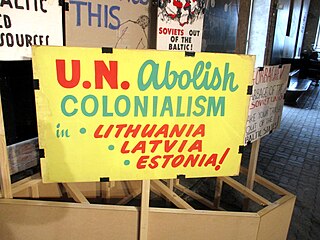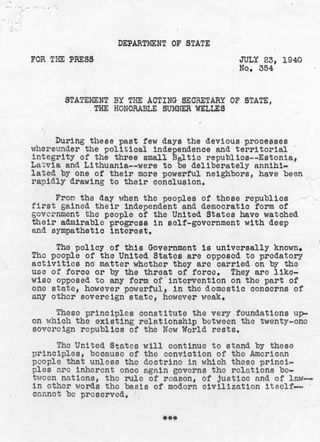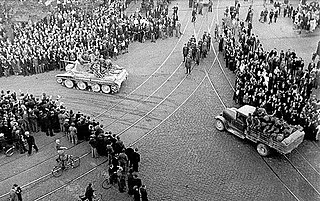Related Research Articles

The Stimson Doctrine is the policy of nonrecognition of states created as a result of a war of aggression. The policy was implemented by the United States government, enunciated in a note of January 7, 1932, to the Empire of Japan and the Republic of China, of non-recognition of international territorial changes imposed by force. The doctrine was an application of the principle of ex injuria jus non oritur. Since the entry into force of the UN Charter, international law scholars have argued that states are under a legal obligation not to recognize annexations as legitimate, but this view is controversial and not supported by consistent state practice.

The Baltic states or the Baltic countries is a geopolitical term encompassing Estonia, Latvia, and Lithuania. All three countries are members of NATO, the European Union, the Eurozone, and the OECD. The three sovereign states on the eastern coast of the Baltic Sea are sometimes referred to as the "Baltic nations", less often and in historical circumstances also as the "Baltic republics", the "Baltic lands", or simply the Baltics.

The three independent Baltic countries – Estonia, Latvia, and Lithuania – were invaded and occupied in June 1940 by the Soviet Union, under the Molotov–Ribbentrop Pact between Nazi Germany and the Soviet Union in August 1939, immediately before the outbreak of World War II. The three countries were annexed by the Soviet Union as "constituent republics" in August 1940. Most Western countries did not recognise this annexation, and considered it illegal. On 22 June 1941, Nazi Germany invaded the Soviet Union and within weeks occupied the Baltic territories. In July 1941, the Third Reich incorporated the Baltic territories into its Reichskommissariat Ostland. As a result of the Red Army Baltic Offensive of 1944, the Soviet Union recaptured most of the Baltic states and trapped the remaining German forces in the Courland Pocket until their formal surrender in May 1945.

The Latvian diplomatic service in exile was the only governmental body of the Republic of Latvia which continued its activities during the Nazi and Soviet occupation of Latvia during 1940–1991. Latvian diplomats who were stationed in embassies and consulates at the moment of the occupation in 1940, refused to recognize the occupation and return to Soviet Latvia. They continued to formally represent the interests of Latvia in countries that did not recognize the Soviet annexation. After the restoration of Latvian independence in 1991, the diplomats started reporting to the restored Latvian Ministry of Foreign Affairs.

After the German invasion of the Soviet Union, the Baltic states were under military occupation by Nazi Germany from 1941 to 1944. Initially, many Estonians, Latvians, and Lithuanians considered the Germans liberators from the Soviet Union.

The three Baltic countries, or the Baltic states – Estonia, Latvia, and Lithuania – are held to have continued as legal entities under international law while under the Soviet occupation from 1940 to 1991, as well as during the German occupation in 1941–1944/1945. The prevailing opinion accepts the Baltic thesis of illegal occupation and the actions of the USSR are regarded as contrary to international law in general and to the bilateral treaties between the USSR and the three Baltic countries in particular.

The German–Soviet Boundary and Friendship Treaty was a second supplementary protocol of the Molotov–Ribbentrop Pact of 23 August 1939. It was a secret clause as amended on 28 September 1939 by Nazi Germany and the Soviet Union after their joint invasion and occupation of sovereign Poland. It was signed by Joachim von Ribbentrop and Vyacheslav Molotov, the foreign ministers of Germany and the Soviet Union respectively, in the presence of Joseph Stalin. Only a small portion of the protocol, which superseded the first treaty, was publicly announced, while the spheres of influence of Nazi Germany and the Soviet Union remained secret. The third secret protocol of the Pact was signed on 10 January 1941 by Friedrich Werner von Schulenburg and Molotov, wherein Germany renounced its claims to portions of Lithuania, only a few months before their anti-Soviet Operation Barbarossa.

The German–Estonian Non-Aggression Pact was signed in Berlin on June 7, 1939, by Estonian and German Foreign Ministers Karl Selter and Joachim von Ribbentrop. The German–Latvian Non-Aggression Pact was also signed on the same day. Ratifications of the German-Estonian Pact were exchanged in Berlin on July 24, 1939, and it became effective the same day. It was registered in League of Nations Treaty Series on August 12, 1939. The pact was intended for a period of ten years.

The German–Latvian Non-Aggression Pact was signed in Berlin on June 7, 1939.

Relevant events began regarding the Baltic states and the Soviet Union when, following Bolshevist Russia's conflict with the Baltic states—Lithuania, Latvia and Estonia—several peace treaties were signed with Russia and its successor, the Soviet Union. In the late 1920s and early 1930s, the Soviet Union and all three Baltic States further signed non-aggression treaties. The Soviet Union also confirmed that it would adhere to the Kellogg–Briand Pact with regard to its neighbors, including Estonia and Latvia, and entered into a convention defining "aggression" that included all three Baltic countries.

The Welles Declaration was a diplomatic statement issued on July 23, 1940, by Sumner Welles, the acting US Secretary of State, condemning the June 1940 occupation by the Soviet army of the three Baltic countries – Estonia, Latvia, and Lithuania – and refusing to diplomatically recognize their subsequent annexation into the Soviet Union. It was an application of the 1932 Stimson Doctrine of nonrecognition of international territorial changes that were executed by force and was consistent with US President Franklin Roosevelt's attitude towards violent territorial expansion.

Executive Order 8389 Protecting Funds of Victims of Aggression was issued by U.S. President Franklin D. Roosevelt on April 10, 1940, following the invasions of Denmark and Norway by Nazi Germany.

The background of the occupation of the Baltic states covers the period before the first Soviet occupation on 14 June 1940, stretching from independence in 1918 to the Soviet ultimatums in 1939–1940. Lithuania, Latvia, and Estonia gained independence in the aftermath of the Russian revolutions of 1917 and the German occupation which in the Baltic countries lasted until the end of World War I in November 1918. All three countries signed non-aggression treaties with the Soviet Union in the 1920s and 1930s. Despite the treaties, in the aftermath of the 1939 German–Soviet pact, Estonia, Latvia and Lithuania were occupied, and thereafter forcibly incorporated into the Soviet Union, in 1940.

The three Baltic states – Estonia, Latvia and Lithuania – were re-occupied in 1944–1945 by the Soviet Union (USSR) following the German occupation. The Baltic states regained independence in 1990–1991.

The Soviet occupation of the Baltic states covers the period from the Soviet–Baltic mutual assistance pacts in 1939, to their invasion and annexation in 1940, to the mass deportations of 1941.

The Soviet Union (USSR) occupied most of the territory of the Baltic states in its 1944 Baltic Offensive during World War II. The Red Army regained control over the three Baltic capitals and encircled retreating Wehrmacht and Latvian forces in the Courland Pocket where they held out until the final German surrender at the end of the war.

The Soviet–Estonian Mutual Assistance Treaty, also known as the Bases Treaty was a bilateral treaty between the Soviet Union and Estonia, signed in Moscow on 28 September 1939. The treaty obliged both parties to respect each other's sovereignty and independence, and allowed the Soviet government to establish military bases in Estonia. These bases facilitated the Soviet takeover of the country in June 1940.

The Soviet–Latvian Mutual Assistance Treaty was a bilateral treaty between the Soviet Union and Latvia, signed in Moscow on October 5, 1939. The treaty obliged both parties to respect each other's sovereignty and independence, while in practice allowed the Soviet government to establish military bases in Latvia, which facilitated the Soviet invasion of the country in June 1940.

The Baltic Legations were the missions of the exiled Baltic diplomatic services from 1940 to 1991. After the Soviet occupation of the Baltic states in 1940, the Baltic states instructed their diplomats to maintain their countries' legations in several Western capitals. Members of the Estonian diplomatic service, the Latvian diplomatic service and the Lithuanian diplomatic service continued to be recognised as the diplomatic representatives of the independent pre-World War II states of Estonia, Latvia and Lithuania, whose annexation by the Soviet Union was not recognised by the United States, the United Kingdom, or France. The legations provided consular services to exiled citizens of the Baltic states from 1940 to 1991.

The guerrilla war in the Baltic states was an insurgency waged by Baltic partisans against the Soviet Union from 1944 to 1956. Known alternatively as the "Forest Brothers", the "Brothers of the Wood" and the "Forest Friars", these partisans fought against invading Soviet forces during their occupation of the Baltic states during and after World War II. Similar insurgent groups resisted Soviet occupations in Bulgaria, Poland, Romania and Ukraine.
References
- 1 2 John Hiden, Vahur Made, David J. Smith, editors (2008). The Baltic question during the Cold War. Routledge. ISBN 978-0-415-37100-1.
{{cite book}}:|author=has generic name (help)CS1 maint: multiple names: authors list (link) - ↑ "Franklin D. Roosevelt - 1940". Federal Register . Retrieved 2009-05-11.
- ↑ "Recognizing the 60th anniversary of the United States nonrecognition policy of the Soviet takeover of Estonia, Latvia, and Lithuania and calling for positive steps to promote a peaceful and democratic future for the Baltic region". Embassy of the United States - Estonia. Archived from the original on July 3, 2008. Retrieved 2009-05-11.
Whereas on July 15, 1940, President Franklin D. Roosevelt issued Executive Order No. 8484, which froze Baltic assets in the United States to prevent them from falling into Soviet hands
- 1 2 3 Hiden, John; Vahur Made; David J. Smith (2008). The Baltic question during the Cold War. Routledge. p. 209. ISBN 978-0-415-37100-1.